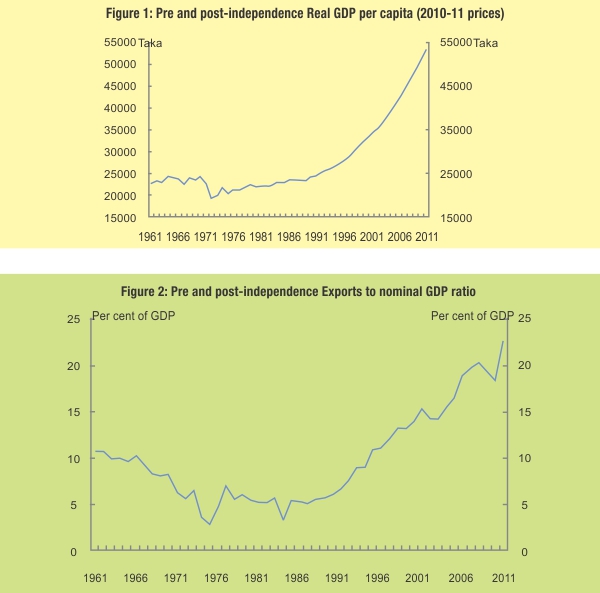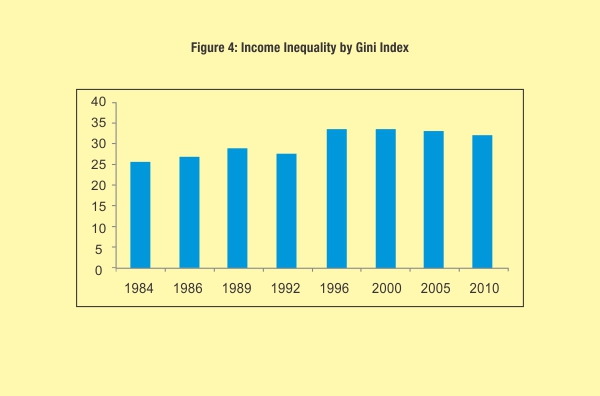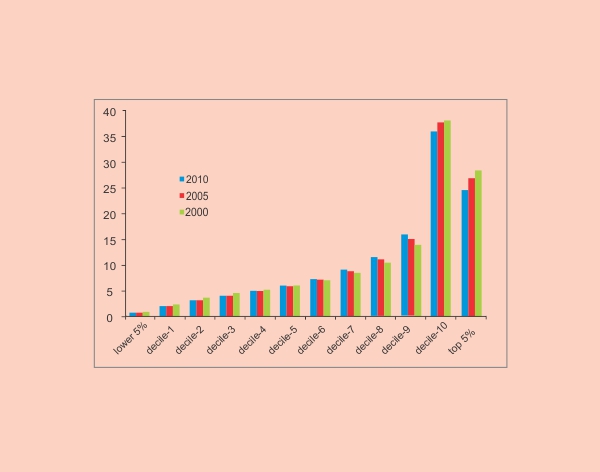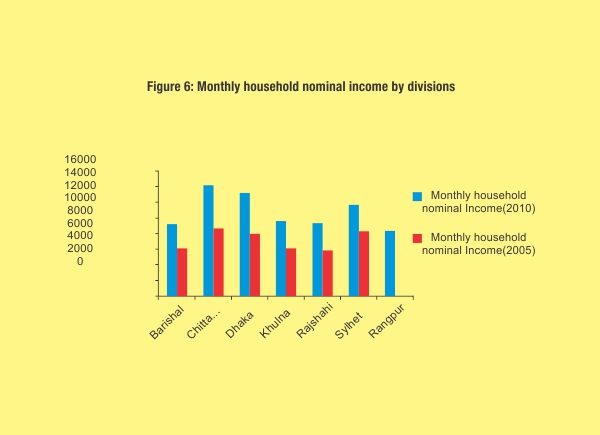
Inside
Original Forum |
| Photo Feature -- Lives in Ruins |
Missed Euphoria |
| The Story of December 1971 -- Syed Badrul Ahsan |
| Surrender at Ramna Racecourse -- Break of a new dawn after endless nightmares -- Ziauddin Choudhury |
| Seeking Refuge -- Tawheed Rahim |
Bangladesh's Quest for Freedom and Economic Equality --- Syeed Ahamed and Rezwana Abed |
Photo Feature |
Bangladesh media: Caught in censorship's crossfire? -- Hana Shams Ahmed |
Weak Father, Strong Mother and (In)visible Nation: Genre and narrative in Bangladesh popular cinema -- Zakir Hossain Raju |
| Bowling Chinamans with Shehan Karunatilaka -- Quazi Zulquarnain Islam |
| Bolstering Country Image through Consular Services: Perspectives from the Bangladesh Embassy in Washington, DC -- Syed S. Andaleeb and M. Humayun Kabir |
| Endnote -- Kajalie Shehreen Islam |
Bangladesh's Quest for
Freedom and Economic Equality
SYEED AHAMED and REZWANA ABED evaluate how much better off
economically the nation is since independence.

The birth of Bangladesh in 1971 was a momentous event within the post-colonial order of South Asia. If we revisit the history of Bangladesh, it becomes evident that acute regional economic inequality had been a major source of discontent and a driving force behind our movement for independence. The emergence of Bangladesh as a separate nation-state was the product of people's movement that challenged the persistent denial of political and economic rights of the people of this land. The yearning for an end to acute economic exploitation and demand for regional political autonomy merged together to evoke a plethora of anti-colonial and nationalist sentiments which culminated in our movement for independence. Hence, the success of Bangladesh as a separate state should not just be weighed by its economic development, but by the very goals it promised to achieve through independence -- alleviation of economic and political inequality. This article revisits Bangladesh's journey during more than four-decades in this attempt.

Why Bangladesh?
To measure Bangladesh's success as an independent nation, one needs to weigh Bangladesh's performance on two grounds -- a. how Bangladesh is better off as an independent nation; and b. to what extent the purpose of independence has been addressed in post-independence Bangladesh.
As has been evident in the history, in addition to the spontaneous anti-colonial movements, Bengali nationalist sentiments emerged time and again in the context of conflicting economic, political and communal interests. It was also articulated in 1905 when the Government of India, on the pretext of improving the administration's effectiveness and communications in the East, partitioned Bengal and established the new province of Eastern Bengal and Assam. While the partition stirred up nationalist sentiments for the middle and upper classes in Kolkata, the Muslims of Bengal were more concerned with the attainment of economic progress and hoped that only a separate state would provide them more freedom and political and economic opportunities. When constant opposition, primarily from the Hindu upper class, forced the British government to annul the partition in 1911, the All India Muslim League, founded in 1906 as a political party to secure the interests of the Muslim diasporas in British India, advanced the notion of the "two nation theory" which suggested that the Hindus and Muslims of the subcontinent needed separate states. British India was partitioned and the sovereign states of India and Pakistan were created along imagined religious lines.
However, Bangladesh's emergence as an independent secular state effectively shattered the 'two nation theory', and demonstrated that religion alone was not sufficient to forge a cohesive national identity. The new state of Bangladesh was the product of a 'Bengali nationalism' that arose to challenge West Pakistan's economic exploitation of its Eastern wing. In the 1950s and 1960s, a group of Bengali economists carefully documented the process of economic disparity and demonstrated how a 'two-economy' system was increasing the economic inequality in the East and West Pakistan. The economic and political demands, as stipulated and enumerated under the six-point programme, were the frontal assault on the foundation of Pakistan's colonial exploitation and authoritarian modes of governance. Hence the General Election of 1970s was fought on the basis of economic and political autonomy and inclusiveness, which reflected the legitimate demands of the people of the then East Pakistan.
Bangladesh emerged out of a quest for economic and political emancipation -- where people's participation will be the key to its development. How far have we succeeded in pursing this goal?

Economic emancipation vs. economic inequality
'Socialism' became part of the fundamental principles of the new nation. So when the post-independence government nationalised all industries that were abandoned by the former Pakistani owners, they nationalised Bengali-owned big industries too to promote public ownership of the means of production and distribution of resources. Then, during the successive authoritarian regimes, Bangladesh jumped from socialism to reverse-socialism and capitalism in pursuit of economic emancipation though growth and/or equality.
In the 1960s, Gross Domestic Product per capita, i.e. per capita income, grew by about 1% a year. Between 1972 and 1991, per capita income grew by only 1.2% a year, whereas per capita income grew by 4% a year between 1991 and 2011. Bangladesh's economic growth was better during the post-independence period, and was accelerated during the post-authoritarian regimes of 1970s and 1980s. Despite all the allegations against successive political regimes, it is proven that Bangladesh economy performed better under political democracy, than any military or quasi-military authoritarian regimes.
Bangladesh has achieved robust and sustained growth of export earnings and exports have become an ever more important part of the economy. While exports accounted for around 5% of the economy in the post-war years, now it accounts for over 20%. More recently, remittances from migrant workers have emerged as a major factor, amounting to over 10% of the economy in recent years. Export performance also demonstrated a similar positive relation with democratic regimes.
During the same period, Bangladesh also moved from aid dependency to self sufficiency as total exports of goods and services were more than six times the foreign aid it received in most recent years. However, to what extent such growth in national earnings has added to human welfare?
With the acceleration in the growth of per capita income, Bangladesh has made considerable progress in poverty reduction. The economic progress has translated into steady decline in poverty rates. During the 1990s, the national incidence of poverty declined from nearly 60% to about 50%; and a much more rapid reduction in poverty seems to have taken place in the following five-year period with the national poverty rate reduced to about 40%.
The economic progress is also reflected in other social indicators. For example, fertility rate has fallen significantly. At independence, each Bangladeshi woman had seven babies on average. Now it is nearly two.
Meanwhile, life expectancy has gone up, while infant mortality rate came down. At independence, 150 infants out of every 1,000 died. Now the number is less than 40.
Amidst all achievements, an important area of concern for Bangladesh is the rise in inequality in the distribution of income. After all, dream of economic emancipation through the alleviation of economic inequality was one of the driving forces of our independence. Regrettably, In Bangladesh, there has been an increase in the degree of inequality in income distribution from the mid-1980s. Gini coefficient, a measure of the inequality of wealth or income distribution, in the country stood at 33.12 in 2010 from 33.22 in 2005. The Gini coefficient was 25.88 in 1984 and went up to 33.46 in 1996.

Bangladesh has remained a country with substantial income inequality with all its manifestations even 41 years after independence. A small section of the society enjoys most of the country's wealth depriving the larger section. Income share held by the highest 10% increased from 21% in 1984 to 27% in 2010. Income share held by the lowest 10% decreased from 4.13% to 3.99%.
The pattern of distribution of income can be seen from percentage share of income of household by decile groups. It is evident from the graph that the gap between the poorest of the poor (bottom 5%) and the richest of the rich (top 5%) is extremely high. In 2005, the income accruing to top 5% of the household was 26.93%, whereas, the same was 0 .77% for the bottom 5% household. In 2000, income accruing to top 5% of the households was 28.34%, whereas the same was .93% for the bottom 5%. It decreased from .93% in 2000 to .77% in 2005. On the contrary, the share of income of the top 5% decreased from 28.34% to 26.93% over the same period indicating that income was accruing at the middle level.
At independence, over 90% of Bangladeshis were villagers, a share that has now come down to nearly 70%. Historical experience suggests that if our economy grows faster, more and more people will flock to the cities. Dhaka in particular has gone from being home to 2% of Bangladeshis to 10% in the past four decades. Lack of decentralisation is causing a growing spatial inequality in income earning, where residents of Dhaka and Chittagong are earning way more than the residents living elsewhere.

To some extent, the situation resembles the colonial domination of Bangladesh by Pakistan wherein economic uplift and development concentrated in the more dynamic/urban part of the country while the rural/informal area suffered from neglect.
Macroeconomic and social indicators show that Bangladesh has been better off as an independent nation though it is far behind in achieving its primary goal of alleviating economic and political inequality. Macroeconomic growth contributed to higher national income, but growing income inequality needs to be addressed. Geographically centralised industrialisation has contributed to a higher flow of domestic migration and export of goods and services helped the national economy gain its self-sufficiency, but it is essential to safeguard and rights of the workers.
We cannot enjoy the independence and victory with the growing income inequality or sufferings of the industrial workers.
Syeed Ahamed and Rezwana Abed are researchers at the Institute of Informatics and Development (IID) and can be contacted at www.iid.org.bd.